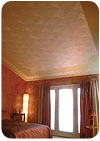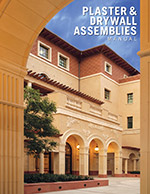
As a young man in England, Steve Selos came to a point in his life when he needed to decide how he was going to make a living. That decision made decades ago, coupled with years of hard work, time traveling across Europe and the choice to leave his native country and bring his craft to the United States, has resulted in breathtaking custom homes that today leave owners, architects and others admiring his craft. Selos is a plasterer, but to leave it at that would be like saying Van Gogh or Rembrandt dabbled in paints. Just as the masters started with a blank slate and brush in hand, Selos starts with many of the same tools as any plastering professional. What is created by the end of the process, though, is far from typical.
ROUGH BEGINNING
England who was not pursuing “higher education,” Selos instead opted for trade school. Originally, his thoughts were to become a stonecutter, but for a very practical reason – the stone-cutting trade school was farther from his home – he opted against his initial leaning. Instead, he decided to study the ancient art of plastering.“I opted for a plastering apprenticeship because it was closer to home and seemed like a good money maker,” Selos says. “My brother was a carpenter and did pretty well financially. He used to let me help out after school and that’s how I got my first experiences.”
Like many apprentice plasterers, the beginning of the experience, and the results on the wall, were far from smooth. Though it’s been nearly 30 years since he started in the profession, he can still remember his first attempts at the craft.
“I can recall the first time working with mud on the hawk and trowel, it all ended up on my boots,” Selos says. “I also remember a teacher who used to say, ‘If you stroke that wall one more time, it’s going to follow you home!’ In England, teachers really work from the ‘cruel to be kind’ philosophy.”
As with everyone who ends up moving from apprentice to professional, the process got smoother, the work got better and things started to fall into place. For Selos, that also meant that he started to find his niche.
WEALTH OF EXPERIENCE
As an apprentice plasterer, Selos had the opportunity to do some maintenance work on Salisbury Cathedral, which was close to his hometown of Swindon, in Wiltshire, England. Because of the timing of his entering the profession, the bulk of his early work was spent rehabbing homes that had been part of the English landscape for generations.“In the late 1970s there was a fair amount of renovation being done on the estates and manor houses which were being handed down to the next generation in very poor condition. Often, the stables or barns were converted into comfortable living areas whilst the main home was being renovated. So I most definitely had my share of renovation work.”
The work was not limited to England, however. Over time, Selos traveled throughout much of Europe, from Belgium to Holland, France to Greece. Along the way, his experiences went far beyond new languages and new customs. He began to get involved in other types of building applications as well. He spent two years working in Germany and was involved with some of the earliest EIFS applications of the time. The same company contracted him to paint the Olympic Village in Munich. They were contracted to do many government buildings and large family housing projects for the military.
“I was fortunate to work with the multi-national team that created the plastic Dryvit pin used to secure foam blocks to walls. This actually came about because we couldn’t get a secure fixture underneath the eves on a four-story gable end because we were on the scaffold.”
COMING TO AMERICA
Despite the fact that he loved traveling through Europe and thoroughly enjoyed working with different techniques, Selos says he also recognized that eventually, he needed new scenery and fresh inspirations to challenge him. Those challenges came on the other side of the Atlantic Ocean, and all the way to the coast of the Pacific, as he settled in California.“I was under a lot of pressure to make a go of things. I had started off working in security and any free time and on weekends, I would drive around studying California construction techniques and styles, whilst getting a sense of scale and techniques between tract and custom homes and I decided to introduce myself to workers at the custom level.”
Not long after he made that decision, Selos got what he describes as his first “big break” when he met an elderly general contractor who happened to be German. The GC let him use some drywall tools that were lying around and Selos did a couple of very rudimentary patterns on an old piece of sheetrock. Because of the contractor’s European background, Selos says, the man appreciated his skills as being trained in traditional plastering. As a result, Selos was introduced to many of the GC’s clients and eventually designed all of the ceilings in what were seven-figure homes.
“I took advantage of that; I armed myself with some good sample boards, printed up some business cards and drove miles every weekend looking for custom home construction sites hoping to bump into owners who were out inspecting progress on their new homes. Very cheekily, I would approach them with my sample boards; it was as basic as that. I soon created a name for myself as the English guy who does fancy ceiling work.”

STYLE, REPUTATION GROW
While he may have started as the English guy who did fancy ceilings, Selos soon developed a reputation as much more. His work moved from ceilings to walls and the scope of his work moved from decorative patterns to true works of art. He also continued to work in relief plastering, the centuries-old craft of plaster work that also incorporates sculpture and painting. The craft and Selos’ expertise in doing it moved him from the realm of the tradesman to that of the artist.Today, his work can range from patterns on a ceiling to an intricate, flowing piece of art created on walls and ceilings rather than canvas. One grand entryway that he considered his masterpiece took more than nine months to design and complete.
One of the challenges of developing this trade in the United States was the wide variety of architecture already in place and being built new at the time. These varying styles, matched to the varying tastes of the homeowners involved, meant that Selos had to develop a broad range of techniques and styles to match the diversity in the market. Despite the changes, though, and no matter the job at hand, the process can still be traced back centuries.
“The process of my work has evolved greatly over the years I’ve spent here in the U.S. However, the technical process is much the same as it was hundreds of years ago. You prepare (and sometimes this means repair) the surface to accept the finish materials and that gives you enough time to be able to create the pattern/texture you are looking for. The magic is actually in the pre-design stage. That’s when all the creative decisions are made; which surfaces to work on, what shape of design, where do I start the design, is there any architecture that I can use to emphasize the design?”
Using the interplay of textures, Selos controls the design that is sought, be it traditional or contemporary, freeform or anywhere in between. “It could include added elements of drama with long, sweeping arches, or strong, straight lines created with the flourish of the tools or the pressure I exert applying plaster to the surfaces to create the kind of impact that draws “ohhs and ahhs” from the clients.”
SEEING IS BELIEVING
For Dr. Frank Finazzo, a Fontana, Calif.-based dentist, his first contact with Selos’ art came at a neighbor’s house, where Selos had done plaster relief work on several of the ceilings. Before that, Finazzo had seen some rudimentary examples of plaster relief work, but nothing like Selos’ work.“I thought, ‘Wow, that was really cool,’” Finazzo said. At the time, he and his family were putting a new addition on their home, and he decided to bring in Selos to design the ceiling in the new room. He did, and from there Selos has done several other rooms within the Finazzo home, all with more of a modern feel.
While Selos said he likes to work with each home or business owner to get a feel for what exactly is sought on a particular project, Finazzo took a more trusting approach.
“I told him basically, you know what you’re doing. Go for it,” Finazzo said, adding Selos did show him examples of what he had in mind. “There was some amount of trust, but I’m a dentist, so I know that at some point, you just have to trust the person who is doing the work.”
The work at his home prompted Finazzo to bring in Selos to design an area at the office of his dental practice as well. A curved wall located directly behind the front desk was done with impregnated marble and uses gold leaf and other elements. While striking visually, it’s perhaps the feel of the finished piece that garners the most attention.
“It honestly feels like glass,” Finazzo said. “People will be standing by it and not really say anything, but when they feel it, you see them turn around very quickly because they’ve never experienced anything like it.”
PASSING DOWN THE TROWEL
While Selos certainly likes to achieve the “wow factor” with his clients, it was Selos himself got quite a jolt not along ago. A little more than a year ago, Selos was diagnosed with diabetes, a disease that threatened not only his life, but also his livelihood. Since that time, he has given a lot of thought to moving from becoming more of a teacher, passing down the skill and knowledge he has gained over a lifetime of work. While not working one-on-one with apprentices on a day-to-day basis, Selos would like to create some form of teaching platform by which his skills and techniques are passed to a new generation of tradesmen.“They must understand that there is a lot to learn; even after an apprenticeship, it will take time to perfect the hand skills, not to mention estimating projects and time management,” Selos says of those who are just starting in the business. He also admits that his specific type of work may not be for everyone, and that’s OK. Just as he did over a lifetime, anyone just starting in the trade needs to find that one element he or she has a passion for, and then work to develop that passion while developing these skills.
“I’d say find what you truly like in the trade, (whether it be) renovation/new construction, exterior work or patch work and then expand on that. You have to follow your passion. I did and I’ve been fortunate. I have traveled well and I’ve been able to take care of my family and myself. I truly believe that there will always be a need for the hand skills of the plastering trade in the future. There will always be domiciles being built and buildings to work in. The materials might change, but someone has to put it together; that’s us, the plasterers.”


